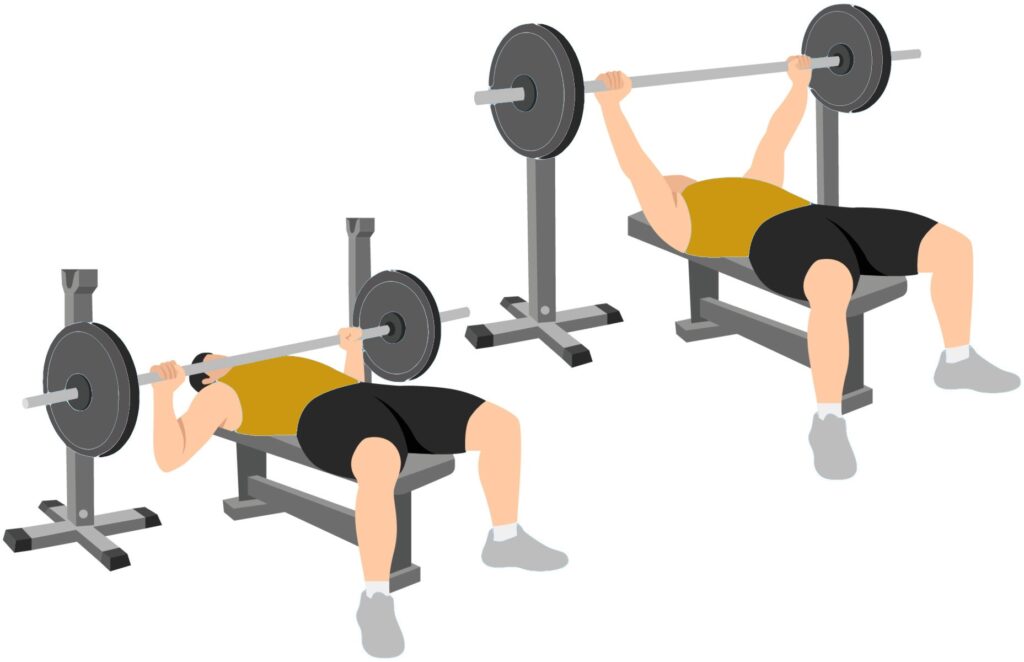If you’re looking to bust your training plateau and challenge yourself to grow stronger and bigger, try adding chains to a bar.
During a basic lift, you perform two main motions. Pressing the weight upwards, aka the concentric, and lowering it down, aka the eccentric phase.

In strength training, the concentric is when your muscles are contracted and shortened as you generate force.
The eccentric is where your muscle lengthens as it goes under tension from lowering the load.
We can think of chains as added weight. However, they serve a more functional purpose in your lift.
Adding chains allows you to overload and increase the resistance you encounter at the strongest portion of the lift.
Chains in the bench press
Let’s use the example of a bench press to illustrate the effect of chains on your lift.
Imagine adding chain links to the barbell.
These chains hang from the bar, and as you lower the bar, the links will gradually hit the floor and start piling up. This effectively reduces the total weight that you’re lifting.
Similarly, as you begin pressing the bar upwards, chain links from the floor start to incrementally add more overall weight to your lift the higher you go.
To summarize, the more chains are resting on the floor, the less weight is added to the bar and vice versa.
Increasing the resistance during the concentric portion of the lift (aka from bottom to up) is safe because you reach stronger joint angles.
Since there is a small element of balancing involved, chains also help prevent voluntary rapid deceleration of the bar, which can happen if you’re trying to rush through the lift.
Often when you’re fatigued during the later reps of your set, you may feel tempted to bring the bar down quickly to your chest. As opposed to keeping strict form on the eccentric (lowering), some lifters may choose to lower the bar quickly to conserve energy for the concentric.
However, if the descent is not properly controlled, lowering the barbell too fast during the bench press can be dangerous and lead to injuries.

When focusing to explode on the concentric movement, you typically stop a few inches shy of your chest to prevent the bar from crashing down onto your sternum. Thus, when performing a quick descent, you also risk not achieving the full range of motion for this exercise.
Keeping chains on the bar forces you to work harder through all ranges of motion to complete the lift. You must consciously produce and maintain the force required to counteract the increasing weight. This helps you achieve hypertrophy, which is a precursor to muscle growth.
Chains also introduce additional instability, which recruits other muscles like the shoulders to compensate for stabilization during the lift. Though to a somewhat lesser degree than resistance bands due to the latter’s elastic tension, chains can still help strengthen your shoulder girdle when bench pressing.
This helps to improve your stability while also reducing the possibility of injuries that may occur if you use a wobble board or stability ball instead.
What are the science-backed benefits of using chains?
A scientific study published in the Journal of Strength and Conditioning tested the theory that including chains with a traditional resistance exercise would enable greater force production to be maintained during the latter stages of the concentric action.
The results showed this to be true and confirmed that larger forces were maintained when heavier chains were added.
According to the study, the increase in variable resistance from the chains led to a slower overall speed and an increase in the rate of force applied.
Typically, in traditional lifts, the start of the eccentric is often where many lifters struggle. For instance, the bottom of a squat or the bottom of a barbell bench press are points where you might fail the lift.
Adding variable resistance in the form of chains increases the force required to move the bar as you complete the range of motion. Conversely, comparatively less force is required when your joint angles are the strongest.
Chains setup
How you set up the chains depends on the lift you’re trying to perform.
For squats, one option is to wrap the chains around the ends of the bar, but a safer way would be to use chains with collars. You can directly attach the chains to the bar and secure it without extra steps.
To get the most from this setup, you want most of the chain links on the ground at the bottom position of the lift. As you complete the lift, theoretically, you should aim to have most if not all the chains off the floor.
You can try placing lifting straps on each side and hanging the chains off them.
This can be tricky to pull off exactly but anything close to what I described is ideal.
